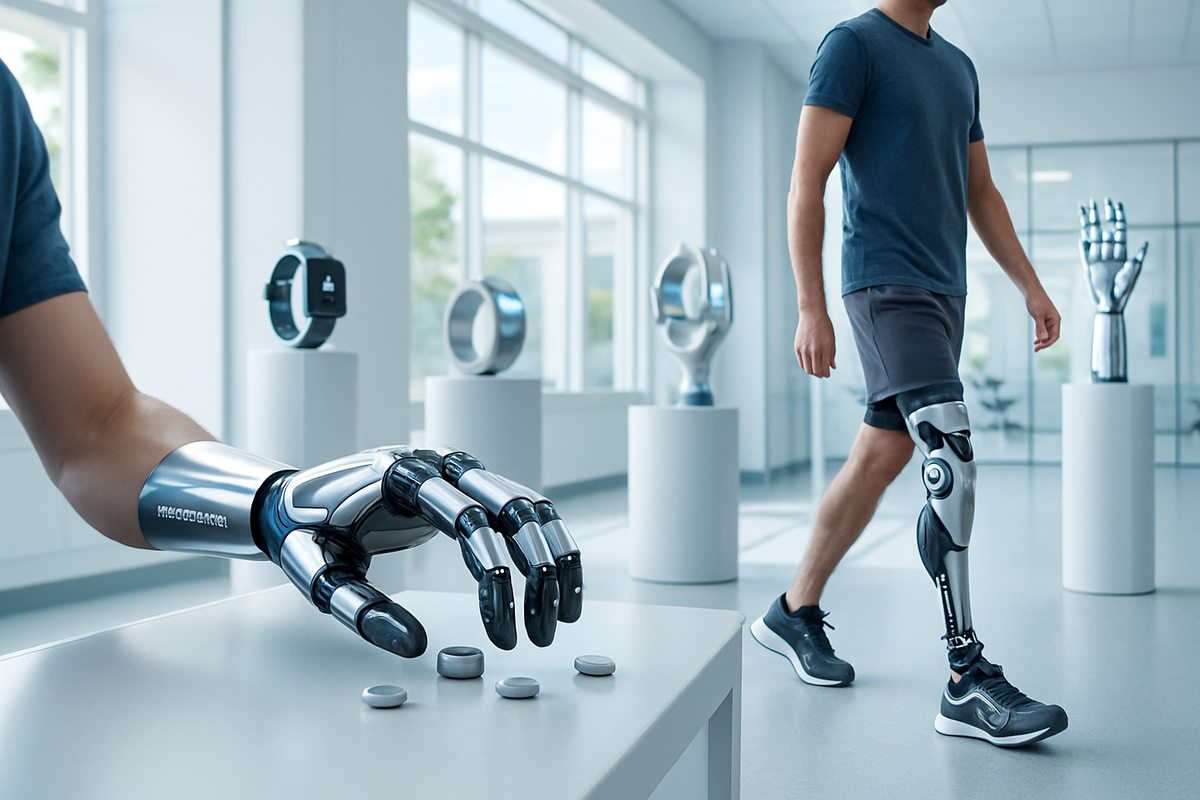The Bionic Age: How AI, 5G, and Smart Wearables Are Revolutionizing Prosthetics in 2025
Step into 2025, where bionic limbs don’t just restore function—they redefine humanity with AI-driven, cloud-connected superpowers. Prosthetics now offer tactile feedback and style, marking a leap in life quality and independence. Welcome to the future.

Welcome to the Bionic Age: Where Sci-Fi Becomes Standard Care
Imagine a world where losing a limb doesn’t mean losing your independence—or your sense of touch. Where prosthetic hands can high-five, fist bump, and even text, not because it’s a futuristic fantasy, but because it’s today’s reality. Welcome to 2025, where AI, 5G, and smart wearables are fusing to redefine what it means to be human.
If you’re new here, or just bionics-curious, you’re in the right place. (And hey, if you want the inside scoop and the power to comment, subscribe for free—subscribers get all the perks, including commenting on our articles. For now, it costs you nothing but a dash of curiosity.)
The New Anatomy: AI, Sensors, and the Sense of Touch
Let’s cut to the chase: prosthetics aren’t just passive limbs anymore. Thanks to advances in artificial intelligence and sensor technology, today’s bionic hands—like the PSYONIC Ability Hand—are restoring something once thought impossible: the sense of touch.
“The Ability Hand is the fastest on the market, impact-resistant, and the first to provide real haptic feedback. When you grip an object, pressure sensors trigger vibrations, letting you feel what you’re holding.”
Why does this matter? For millions of amputees, regaining tactile feedback means safer, more intuitive use—and a massive leap in quality of life. Suddenly, picking up an egg or shaking hands isn’t a calculated risk, but a natural gesture.
Hero Arms and Superpowers: The Rise of Smart, Stylish Prosthetics
Remember when prosthetics tried to blend in? That’s so 2010. Today, Open Bionics’ Hero Arm models are making bionic limbs a badge of pride. These 3D-printed arms are custom-fitted, adorned with superhero flair, and now come with game-changing features:
- Wireless and Waterproof: The 2025 Hero Pro & Hero RGD models work even when detached—yes, you read that right.
- Biofeedback Vibration: Lights and haptics provide real-time cues for grip and movement.
- Custom Grips: Grab, pinch, high-five, or give a thumbs-up with multiple grip modes.
With clinics now across the US and a growing global footprint, Open Bionics isn’t just changing prosthetics—they’re changing culture.
The Ankleband Revolution: Intuitive, Low-Cost Control
What if you could control a robotic hand with a flick of your ankle? Researchers have developed a smart ankleband—a low-cost, calibration-free device that reads your leg gestures using an IMU sensor and a dash of neural network magic. The result? A prosthetic hand that responds instantly and intuitively.
Why is this huge? Traditional myoelectric controls can be finicky, expensive, and tiring. The ankleband approach is accessible, easy to learn, and opens the door to millions who might otherwise be left out of the bionics boom.
Cloud-Connected Limbs: 5G and the Internet of Prosthetics
What’s smarter than a bionic hand? A bionic hand with a cloud IQ. Thanks to 5G connectivity and edge/cloud computing, the newest prosthetics can offload heavy data-processing tasks to the cloud—leaving local processors to focus on real-time control.
- Local + Cloud = Superpowers: Complex AI (like adaptive grip, predictive movement, or health analytics) runs on distant servers, but you still get millisecond responses.
- Always Improving: Firmware and AI models update over-the-air, so your prosthetic gets smarter while you sleep.
“5G isn’t just about speed—it’s about reliability, low latency, and connecting prosthetics to a global brain.”
This is the dawn of the Internet of Limbs. And it’s only getting started.
What’s Next? The Future of Human-Machine Integration
So, what’s on the horizon for bionic tech?
- Full-Body Haptic Suits: Imagine feeling the world through your prosthetic—rain, sand, or a loved one’s touch.
- Smarter AI: Prosthetics that learn your habits, predict your needs, and adapt on the fly.
- Universal Cloud Platforms: Seamless integration with wearables, health records, and even smart homes.
The bottom line: The bionic age isn’t about replacing what’s lost, but about expanding what’s possible—for everyone.
Who’s Driving This Revolution?
- Open Bionics: Low-cost, high-style Hero Arms with wireless and waterproof features.
- PSYONIC: The Ability Hand—bringing speed, strength, and the sense of touch to prosthetics.
- Academic Innovators: Affordable ankleband controls and plug-and-play solutions.
- Cloud and 5G Pioneers: Making sure your limb is as smart as your phone.
This isn’t just about gadgets—it’s about restoring dignity, independence, and joy. And whether you’re a techie, a patient, or just a human rooting for other humans, you’re part of this story.
Ready to Join the Bionic Conversation?
The bionic revolution is moving fast—and so are we. Want to get the latest breakthroughs, real-world stories, and expert insights delivered straight to your brain (okay, your inbox)?
Subscribe for free today at Funaix Insider—only subscribers can comment, discuss, and shape our coverage. The future is collaborative, and your voice belongs in it.
What excites you most about the bionic age? What questions do you have? Subscribe, comment, and let’s build the next chapter of human possibility—together.
Published August 13, 2025 • For full references and research, see source links and citations in the Funaix newsroom.




